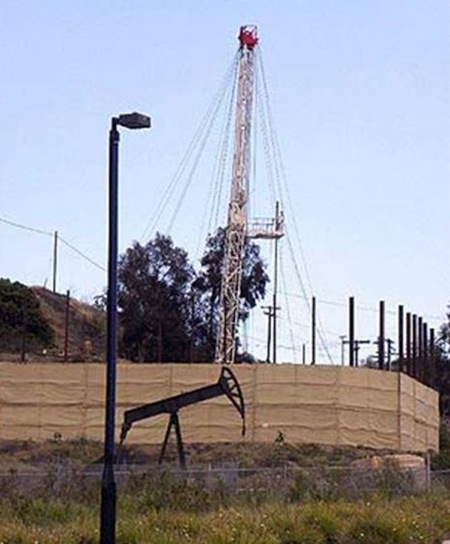Action comes after Culver City sets time line to phase out local oil production
Wave Staff and Wire Reports
LOS ANGELES — The county Department of Public Health announced June 21 it will conduct a second study, led by UCLA research teams, into the health impacts of living near the Inglewood Oil Field.
The county’s announcement came four days after the Culver City Council voted 4-1 in support of an ordinance that will phase out oil production and require the cleanup of well sites in the portion of the Inglewood Oil Field within the city’s borders within five years.
The ordinance is the final step in phasing out drilling in Culver City, which includes the largest urban oil field in the United States, with 10% of the oil field within Culver City’s borders. The ordinance also requires that all wells be properly plugged and abandoned and the well sites and surrounding area be fully remediated by July 28, 2026.
City staff were directed to develop “just transition strategies” to support impacted workers and community residents. Advocates recommended that any displaced workers be transitioned to high-road jobs with the necessary training and wage compensation.
“This vote is a product of years of community organizing and a testament to the power of people who relentlessly speak up for their right to clean air and a healthy and safe environment,” said David Haake, chair of the Sierra Club Angeles Chapter’s Clean Break Committee. “It’s also proof that we don’t have to continue to allow big oil executives to operate unchecked in our backyards.
“Phasing out oil drilling in our communities is both necessary and achievable, and now that Culver City has taken this important step forward, it’s time for the rest of Los Angeles to follow suit.”
The Stand Together Against Neighborhood Drilling Coalition issued a statement after the Culver City vote.
“This is an outcome that every community in Los Angeles deserves,” the coalition said. “The Los Angeles City Council and the Los Angeles County Board of Supervisors must listen and learn from our neighbors in Culver City and work to phase out toxic oil drilling in communities of color, who are most severely impacted by fossil fuel pollution.
“Communities from South Los Angeles to Wilmington have been advocating for over 10 years to see these toxic wells removed from their neighborhoods,” the coalition’s statement continued. “Culver City has shared a model for what a responsible, rapid and equitable just transition can look like — and it’s time for the rest of Los Angeles to follow suit.”
Liz Jones, an attorney at the Center for Biological Diversity’s Climate Law Institute said the Culver City action was the start of the transition away from toxic fossil fuels.
“We don’t need any more spills, air quality alerts or premature deaths to tell us neighborhood drilling is dangerous,” Jones said. “It’s time to end this hazardous practice, and Culver City just showed how.”
“By being bold, Culver City has been able to set the terms for its efforts to end oil drilling – centering community from the very beginning,” said Alexandra Nagy, California Director for Food and Water Watch. “Residents across the state should look to this victory and ask themselves: are my elected officials willing to do the same to protect my health and community?”
“Culver City has the opportunity to finally protect community members from dangerous health risks from oil operations so close to livelihoods,” said Damon Nagami, a senior attorney with the Natural Resources Defense Council. “A swift phaseout and clean-up of these wells can create quality jobs and save lives.”
“Culver City’s vote to phase out oil production and clean up well sites should inspire cities throughout California to prioritize public health and safety,” said Alison Hahm, an attorney with Communities for a Better Environment. “No one should be forced to live on the frontlines of oil drilling.”
As for the county study, UCLA teams will develop and implement the assessment, which will take into consideration residents’ distance from oil fields in an effort to better understand how community health is impacted.
The Department of Public Health will develop the assessment’s protocols in conjunction with UCLA before a review by a community advisory board. The study’s findings will be made available to the public.
“This complex assessment and analysis requires a very specific expertise, which the UCLA team brings to the table,” said county Public Health Director Barbara Ferrer.
“Public Health looks forward to sharing this information to inform efforts to reduce negative health outcomes for the residents in these nearby communities, including higher rates of infant mortality, asthma and cancer.”
The areas around the Inglewood Oil Field include the most affluent Black communities in the nation, including Baldwin Hills, Ladera Heights and View Park/Windsor Hills, Ferrer said.
However, despite high median education and employment levels, the Black residents suffer disproportionately from relaxed regulatory controls on polluting industries compared to affluent white neighborhoods, such as Beverly Hills.
The Beverly Hills Oil Field has stricter design and mitigation measures imposed by state and local regulatory agencies.
The assessment seeks to close the “data gap” and lead to better long-term health outcomes for residents around the Inglewood Oil Field, which has 675 active wells and is adjacent to schools, homes, hospitals, parks and churches.
“After decades of oil drilling, the negative health impacts on nearby residents, who are disproportionately Black and Brown, must be fully examined, and I applaud this important partnership between L.A. County Department of Public Health and UCLA,” said Supervisor Holly J. Mitchell, whose district includes Baldwin Hills, View Park/Windsor Hills, Ladera Heights and Culver City.
“The oil drilling in Baldwin Hills is an issue of health equity and environmental justice that acutely impacts the Black community. The full spectrum of oil drilling-related health impacts on vulnerable communities have been neglected for far too long. I look forward to seeing the results of this study and continuing to improve the health and livability of the neighborhoods in my district.”
More than a million people live within five miles of the Inglewood Oil Field, the nation’s largest urban oil field.













